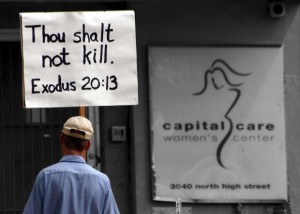 WASHINGTON — The United States Supreme Court has agreed to hear a challenge to a Massachusetts buffer zone law that prohibits pro-life counselors from coming within 35 feet of the entrance and/or driveway of an abortion facility.
WASHINGTON — The United States Supreme Court has agreed to hear a challenge to a Massachusetts buffer zone law that prohibits pro-life counselors from coming within 35 feet of the entrance and/or driveway of an abortion facility.
The case, McCullen v. Coakley, began in 2008 and was filed on behalf of seven pro-life residents that regularly engage in sidewalk counseling outside of abortion facilities in the state. U.S. District Judge Joseph Tauro initially upheld the ordinance, stating that the requirement did not hinder free speech.
“From the evidence,” he wrote in his decision, “it is clear that the Act, as applied at each of the challenged [locations] leaves open ample adequate alternative means of communication.”
The First Circuit Court of Appeals agreed, finding no constitutional infringement inherent in the regulation.
“The Massachusetts statute at issue here is a content-neutral, narrowly tailored time-place-manner regulation that protects the rights of prospective patients and clinic employees without offending the First Amendment rights of others,” the three-judge panel wrote. “The nation is sharply divided about the morality of the practice [of abortion] and its place in a caring society. But the right of the state to take reasonable steps to ensure the safe passage of persons wishing to enter health care facilities cannot seriously be questioned.”
The Planned Parenthood League of Massachusetts then praised the court for its decision.
“Now women, their families, and staff will continue to have the protection they need to have safe and harassment-free access into our health centers,” said President Dianne Luby in a statement. “The Buffer Zone Law protects the dignity and privacy of patients and staff, while also preserving the rights of individual freedom of speech. Today’s decision will ensure that this law will continue to make a difference for patient privacy and for public safety outside of our health centers.”
However, Philip Moran, an attorney for the sidewalk counselors, states that the 35-foot regulation hinders effective communication, and prohibits some forms of speech altogether.
“You can’t stand outside 35 feet and communicate with people,” he told The Boston Globe. “You have to have eye contact.”
One-on-one personal conversations and the distribution of literature would not be possible within the buffer zone area.
Buffer zones and bubble zones are increasingly being used in municipalities across America, and have been generally upheld in the lower courts. Recently, government officials in San Francisco approved a 25-foot expanded buffer zone around abortion facilities in the city in order to keep abortion-minded women free from “harassment.” Cities in New York, Illinois and Massachusetts have similar laws, and abortion supporters have been pushing for bubble and buffer zones in other states, such as Maine and Georgia.
According to SCOTUS Blog, the Supreme Court will now decide “whether the First Circuit erred in upholding Massachusetts’s selective exclusion law – which makes it a crime for speakers other than clinic ’employees or agents . . . acting within the scope of their employment’ to ‘enter or remain on a public way or sidewalk’ within thirty-five feet of an entrance, exit, or driveway of ‘a reproductive health care facility’ – under the First and Fourteenth Amendments, on its face and as applied to petitioners; [and] whether, if Hill v. Colorado permits enforcement of this law, Hill should be limited or overruled.”
Become a Christian News Network Supporter...


